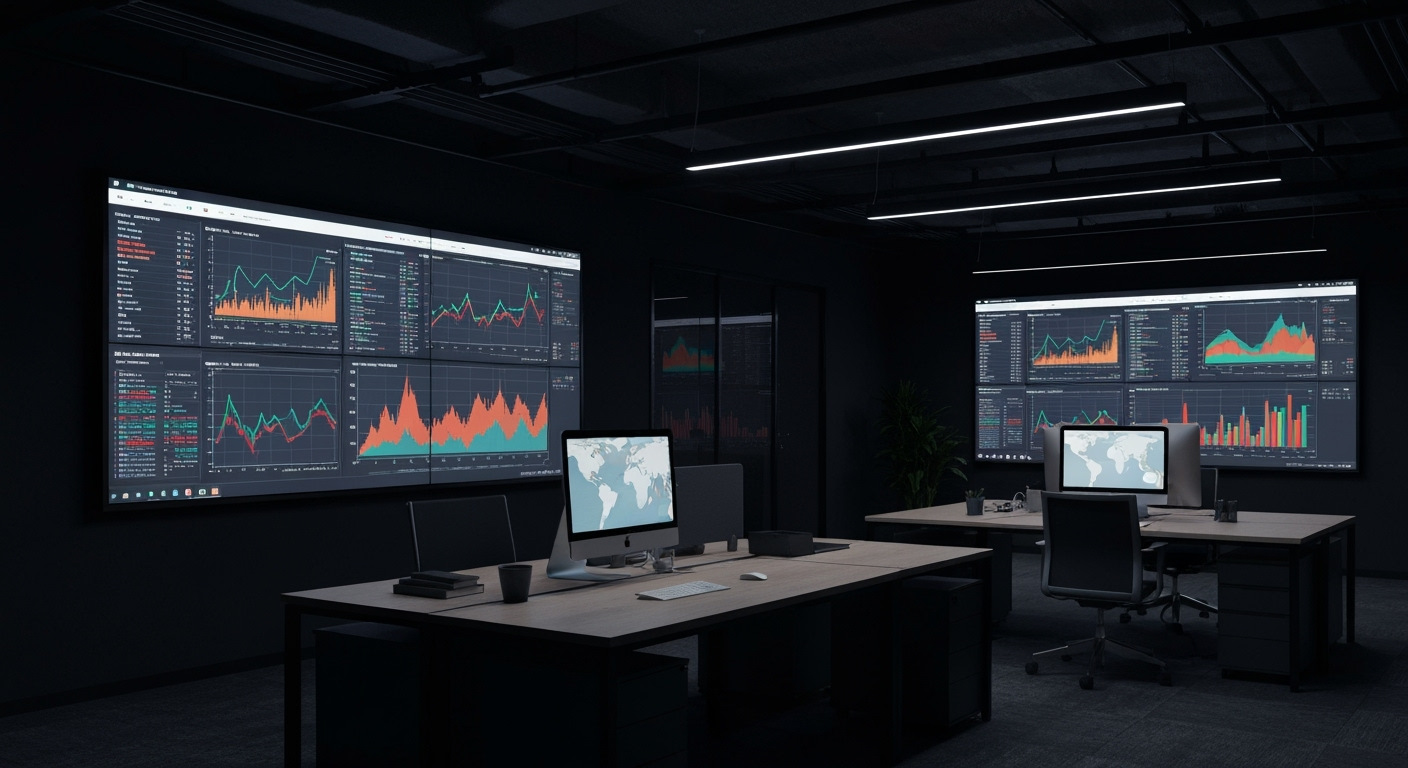Understanding Google's Core Updates and Their Impact
Google core updates represent significant algorithmic shifts designed to enhance the relevance, quality, and user experience of search results. Though not penalties, these updates often lead to noticeable fluctuations in website rankings and traffic. For many site owners and SEO professionals, experiencing a drop in rankings after such an update can be both perplexing and alarming. This article provides a comprehensive guide to understanding the nature of Google core updates, diagnosing ranking declines, implementing effective recovery strategies, and future-proofing websites against similar fluctuations.
What Are Google Core Updates and How Do They Impact Website Rankings?
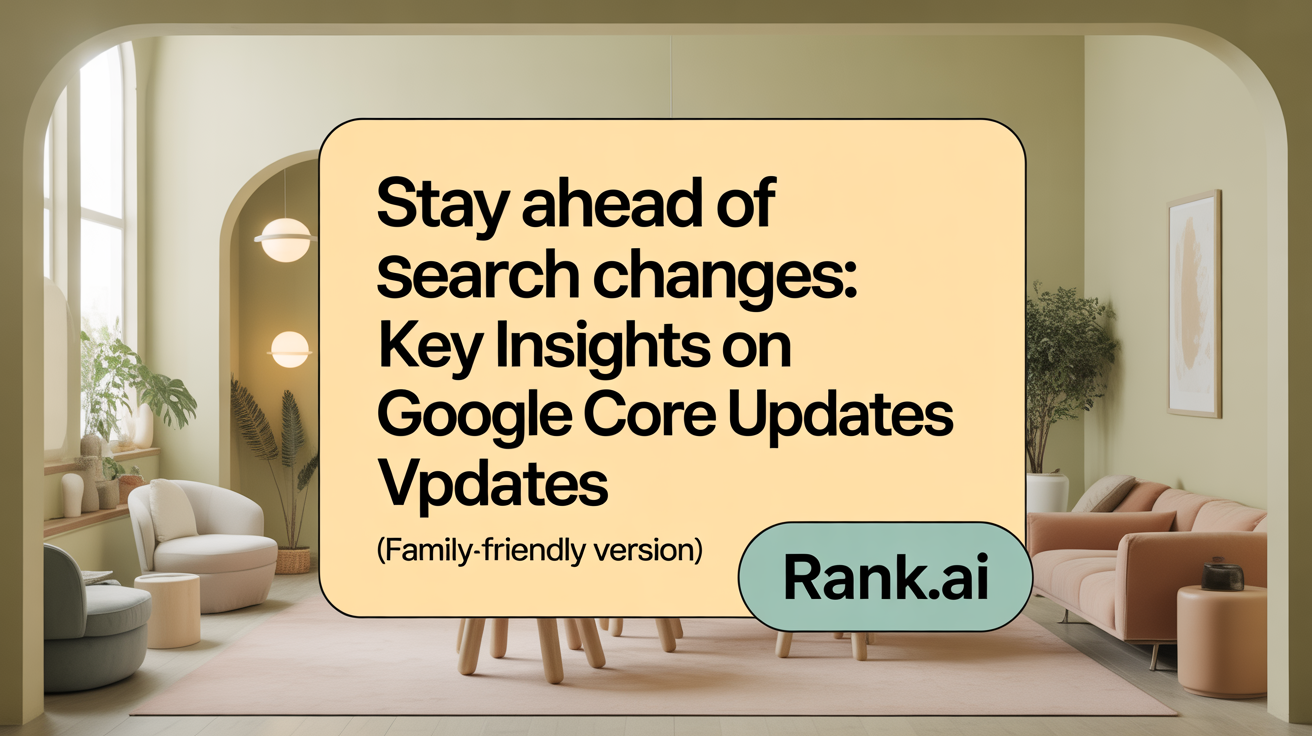
What are Google core updates and how do they impact website rankings?
Google core updates are comprehensive changes made to Google’s search algorithm, released several times each year to improve the relevance, quality, and usefulness of search results. These updates are broad in scope and affect how Google evaluates various ranking factors, including the quality of content, backlinks, user experience, and relevance.
Unlike penalties, which target specific violations such as spam or black-hat SEO tactics, core updates do not impose direct penalties. Instead, they are meant to recalibrate the way Google assesses and ranks websites, which can lead to fluctuations, sometimes dramatic, in search rankings and traffic.
The impact of these updates is often felt across entire industries or topics, with some sites rising while others fall. This is primarily because Google updates its understanding of user intent and revises the importance of different ranking signals accordingly.
A critical aspect of maintaining or improving rankings after a core update is adhering to Google’s E‑E‑A‑T principles:
| E – Experience | E – Expertise | A – Authority | T – Trustworthiness |
|---|
Websites that demonstrate a clear experience, expertise, authority, and trustworthiness tend to fare better in the updated search environment.
In summary, Google core updates are designed to make search results more helpful and relevant by aligning ranking factors with the evolving understanding of user needs. Regularly updating content, improving site quality, and focusing on user satisfaction are essential strategies to mitigate potential negative impacts and sustain visibility in search results.
Common Causes for Sudden Ranking Drops After a Core Update
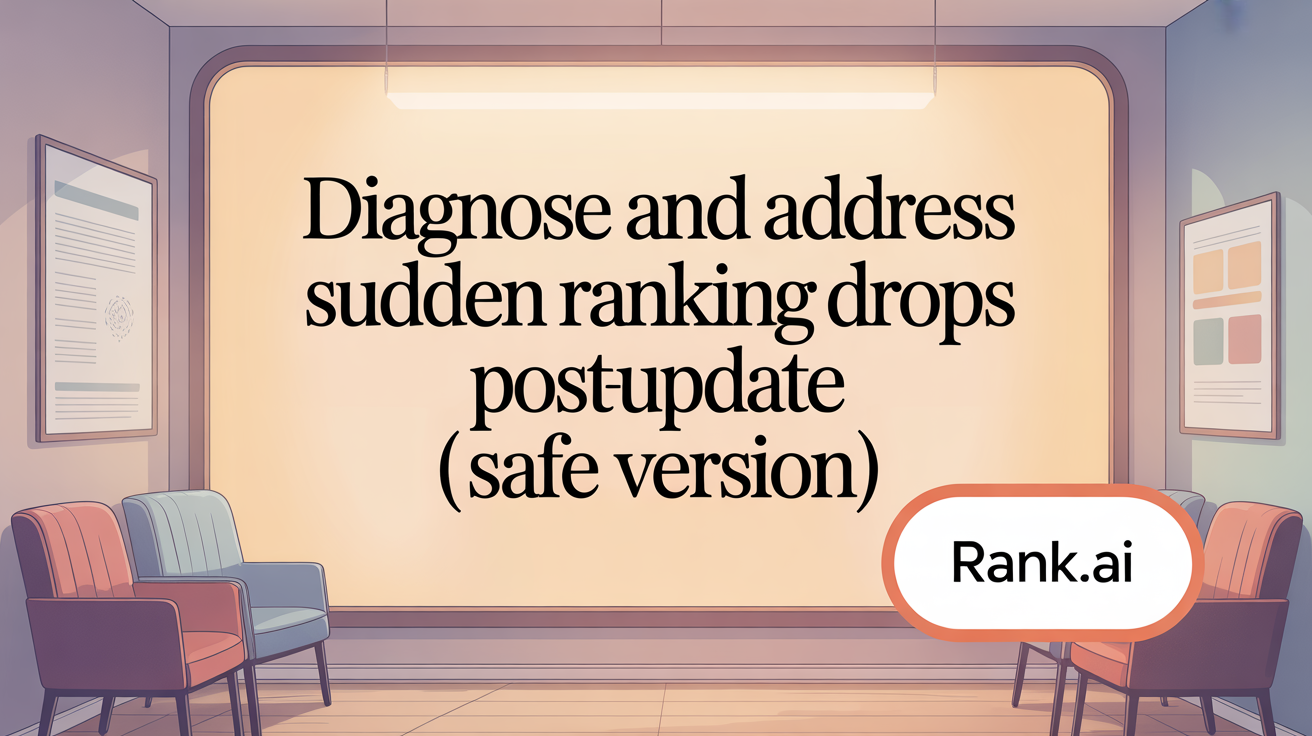
Why might a website's Google ranking suddenly drop after a core update?
A sudden decline in Google rankings following a core update often points to changes in how Google evaluates and ranks websites. These updates are designed to enhance search result relevance and quality by reassessing factors like content value, authority, and technical robustness.
One common reason for ranking drops is a reevaluation of content relevance and quality. Google’s core updates emphasize the importance of high-quality, helpful content that meets user intent. If your content is outdated, thin, or lacks depth, it may no longer meet the new standards, leading to lower rankings.
Technical SEO issues can also cause significant ranking declines. Problems such as crawl errors, site speed issues, canonicalization mistakes, or improper indexing prevent Google from properly crawling and understanding your site. This hampers visibility in search results and can cause rankings to fall.
Another critical factor is the backlink profile. Loss of authoritative backlinks or the presence of toxic, spammy links may diminish your site's perceived authority. Google values trust and authority, so negative backlink changes can lead to ranking decreases.
Changes in user experience metrics, especially Core Web Vitals like page load times, interactivity, and visual stability, directly influence rankings. Factors such as site speed, mobile usability, and ad placement can impact these metrics and, consequently, your search visibility.
Finally, recent content modifications or adjustements in SERP layout — such as the addition of rich snippets or feature blocks — can alter your rankings. Plus, increased competition or shifts in search intent might also reposition your site lower in results.
To effectively respond to a ranking drop after a core update, review your website’s health via Google Search Console, analyze backlink changes, evaluate your content’s quality and relevance, and remain updated with Google’s ongoing algorithm updates. Addressing these areas methodically can help recover your visibility and adapt your SEO strategy to new standards.
Diagnosing Ranking Declines: Using Data to Identify Root Causes
Verifying ranking drops using Google Search Console and Analytics
The first step in diagnosing a sudden ranking decline is to verify whether a real drop has occurred. Utilize Google Search Console to analyze performance metrics such as clicks, impressions, and keyword rankings over specific periods. Comparing data before and after the suspected decline can reveal whether rankings have genuinely fallen or if it might be due to tracking errors or seasonal fluctuations. Additionally, review Google Analytics to identify shifts in overall traffic, user engagement, and conversions, which can offer insights into the impact.
Analyzing timing versus Google update rollout
Next, check whether the decline correlates with a known Google algorithm update. Major updates like core updates often have specific rollout windows. Cross-reference your data with official announcements from Google's Search Liaison or SEO news sources. Timing is important: declines that align with update dates likely indicate the update’s impact rather than site-specific issues.
Checking for manual actions or security issues
Visit Google Search Console to inspect for manual actions or security problems. Manual penalties for spam, unnatural links, or malware warnings can cause ranking drops. Fixing these issues and requesting reconsideration can expedite recovery. Ensuring your site is secure and not compromised is crucial, as security breaches not only harm rankings but also trustworthiness.
Identifying technical and content changes
Review recent updates to your website—such as changes to internal links, content updates, URL canonicalization, or server configurations—that could influence crawling and indexing. Conduct a technical SEO audit using tools like PageSpeed Insights or Screaming Frog to detect issues like crawl errors, slow load times, duplicate content, or redirected URLs. Outdated or thin content may also contribute to declines, especially post-relevant updates emphasizing high-quality content.
Monitoring SERP features and competitor movements
Observe shifts in the Search Engine Results Page (SERP). The appearance of new features like rich snippets, People Also Ask boxes, or AI-driven features can push your rankings down even if your page remains unchanged. Comparing your site’s performance to competitors helps identify content gaps or improvements needed—such as better answer quality, user engagement, or topical authority.
Analyzing user engagement and Core Web Vitals
Finally, evaluate user engagement metrics such as bounce rates, time on page, and conversion rates. Concurrently, review Core Web Vitals—loading performance, interactivity, and visual stability. Poor scores may indicate user experience issues that could harm rankings. Improving these signals often helps restore or boost your site’s visibility.
In summary, diagnosing ranking declines involves a layered approach: confirm the decline with analytics, check alignment with Google updates, address technical and security issues, analyze content relevance, monitor SERP feature changes, and assess user signals. By systematically examining these factors, website owners can accurately identify underlying causes and implement targeted recovery strategies.
Conducting Comprehensive Technical SEO Audits Post-Update
What technical SEO areas should be reviewed and optimized in response to ranking changes caused by Google core updates?
Following a Google core update, it’s essential to scrutinize your website’s technical SEO to address any issues that may impact your rankings. Focus on several key areas to ensure your site remains healthy and competitive.
First, prioritize site speed and mobile usability. Google emphasizes fast-loading, mobile-friendly websites, especially with Core Web Vitals becoming a ranking factor. Use tools like Google PageSpeed Insights to identify and fix loading delays, optimize images, and improve server response times.
Next, examine crawlability and indexation. Make sure your robots.txt file and sitemap are correctly configured so that search engines can effectively crawl and index your pages. Clarify URL structures and eliminate broken links or redirects that could block access.
Verifying your robots.txt, sitemap, and canonical tags is also crucial. Accurate canonical tags prevent duplicate content issues by informing search engines which version of a page to index. Ensure these elements are correctly implemented across your website.
Address duplicate content issues by consolidating similar pages or using canonical tags appropriately. Duplicate content can dilute ranking signals and confuse search engines.
Security remains a top priority. Check that your website uses HTTPS with a valid SSL certificate. Regularly scan for malware or hacking issues, as security breaches can harm your credibility and rankings.
Structured data, like Schema markup, enhances your site's visibility in search results and prepares your site for AI-driven features. Ensure your structured data is correctly implemented, relevant, and free of errors.
Regular technical audits should be part of your SEO routine. Use comprehensive tools and methods to monitor your site's health, fix issues promptly, and align your strategy with Google’s evolving guidelines.
By systematically reviewing these technical elements, you can address vulnerabilities exposed or exacerbated by algorithm updates, improve user experience, and foster better rankings.
| Focus Area | Optimization Tips | Tools & Resources |
|---|---|---|
| Site Speed & Mobile Usability | Optimize images, reduce server response time, ensure mobile responsiveness | Google PageSpeed Insights, Lighthouse |
| Crawlability & Indexation | Use robots.txt, submit XML sitemap, monitor crawl stats | Google Search Console, Screaming Frog |
| Robots.txt, Sitemap, Canonical Tags | Correct configuration, avoid duplicate URLs | Google Search Console, SEO audit tools |
| Broken Links & Duplicate Content | Fix or remove broken links, implement rel=canonical | Broken Link Checker, Screaming Frog |
| Security & Malware Checks | Use HTTPS, scan for vulnerabilities | SSL Labs, Sucuri SiteCheck |
| Structured Data & Schema | Add relevant schema markup, validate errors | Google Rich Results Test, Schema.org |
Staying proactive with technical SEO audits ensures your website maintains optimal performance and visibility. Regularly update your strategies to meet Google’s standards and adapt to algorithm changes for sustained ranking success.
Performing Content Audits to Align with E-E-A-T Principles

What are effective strategies for improving content quality to better align with Google's core update requirements?
Improving content quality is essential when trying to recover from ranking drops following Google’s core updates. Start by creating content that is highly relevant, well-researched, and focused on satisfying search intent. This means thoroughly analyzing what your target audience wants and delivering comprehensive, valuable information.
Regularly updating existing pages with the latest facts and figures ensures your content remains fresh and accurate. Incorporating multimedia elements such as images, videos, and infographics can enhance user engagement and help illustrate key points effectively.
Optimizing content for relevant long-tail keywords improves its visibility for specific queries while maintaining a natural flow that prioritizes user readability. Ensuring your website’s technical health — including fast loading times, mobile friendliness, and easy navigation — supports a positive user experience.
Building backlinks from reputable sites adds authority, which influences rankings favorably. Additionally, maintaining a clean, error-free website and monitoring search performance with analytics tools allows you to identify areas for further improvement.
A long-term approach that promotes original, comprehensive, and helpful content, combined with staying updated on algorithm changes, can significantly enhance your site’s adherence to Google’s standards. This strategic focus not only aids recovery but also sustains higher visibility over time.
Backlink Profile Analysis and Management Strategies
How should backlink profiles be assessed and managed to mitigate negative effects from Google algorithm updates?
Managing your site's backlink profile is crucial, especially after significant Google algorithm updates. Start by conducting thorough audits using tools like Ahrefs, Semrush, or Moz to identify low-quality, spammy, or harmful backlinks. Disavowing these links promptly is essential to prevent potential penalties that could harm your rankings.
Regularly monitor your backlink profile to spot any sudden losses of valuable links or the emergence of toxic ones. Keeping track of your link growth and profile health helps you stay ahead of algorithm changes. Comparing your backlink patterns with those of your competitors can reveal industry standards and uncover opportunities for ethical link-building.
Focusing on acquiring high-authority, relevant backlinks is vital. These links should come from reputable sources related to your niche and align with your content’s intent. Maintaining a natural, diverse link profile minimizes the risk of penalties and signals to Google that your site is trustworthy.
Moreover, evaluating the impact of algorithm updates involves analyzing traffic fluctuations and affected pages within Google Search Console and analytics platforms. This insight guides targeted improvements in content and technical SEO.
A long-term backlink strategy includes producing high-quality, shareable content, outreach for authoritative links, and ongoing cleanup of harmful links. By doing so, you build resilience against future algorithm changes, helping sustain and grow your search rankings over time.
| Step | Action | Purpose | Additional Details |
|---|---|---|---|
| 1 | Conduct backlink audit | Identify low-quality and harmful links | Use tools like Semrush, Ahrefs |
| 2 | Disavow toxic links | Prevent penalties | Use Google Disavow Tool |
| 3 | Monitor backlinks regularly | Maintain profile health | Track with link audit tools |
| 4 | Compare with competitors | Discover standard and successful strategies | Analyze top-ranking sites |
| 5 | Build relevant links | Enhance authority | Focus on industry-related, high-trust sites |
| 6 | Diversify backlink profile | Reduce risk | Obtain links from various domains |
| 7 | Analyze impact of updates | Adjust strategy accordingly | Review traffic patterns in Search Console |
Following a strategic, curated approach to backlinks not only mitigates the risks posed by Google algorithm updates but also establishes a sustainable foundation for long-term SEO success.
Competitive Analysis: Learning From Top Performers

Comparing keyword rankings and content quality
Analyzing top-ranking competitors helps you understand what search engines favor for your target keywords. Use tools like SEMrush or Ahrefs to assess which sites occupy the top spots and evaluate their content quality, depth, and relevance. High-ranking pages often provide comprehensive, well-structured information that aligns with user intent. Comparing these factors with your site allows you to identify areas where your content may need improvement.
Identifying content gaps and opportunities
Searching for keyword gaps helps uncover topics your competitors cover that you haven't yet addressed. Tools like Ahrefs Content Gap or SEMrush Keyword Gap can reveal high-value keywords your rivals rank for but you don’t. Filling these gaps with in-depth, high-quality content positions your site as a comprehensive resource, which can lead to higher rankings and increased traffic.
Studying competitor backlink profiles and strategies
Backlinks remain a critical ranking factor. Examine your competitors’ backlink profiles using tools like Majestic or Ahrefs to see where their links are coming from. Look for authority sites linking to them and opportunities to earn similar backlinks through outreach or creating link-worthy content. Spotting toxic or spammy backlinks also allows you to disavow harmful links that could be negatively impacting your rankings.
Adapting to shifts in search intent and SERP features
Search intent can change over time, especially after algorithm updates. Study how competitors' pages align with current user needs—pay attention to features like featured snippets, People Also Ask, or new SERP elements. Adapting your content to match current user queries and incorporating relevant structured data can boost visibility and engagement.
Using competitive insights to refine SEO strategies
Leverage the insights gained from competitor analysis to refine your overall SEO approach. This might include optimizing content for new or emerging keywords, enhancing user experience based on competitor website design, or adjusting your backlink strategy. Continuous monitoring of competitors’ rankings and strategies ensures your SEO efforts remain effective amid evolving search engine algorithms.
| Aspect | What to Analyze | How It Boosts Your SEO | Additional Notes |
|---|---|---|---|
| Keyword Rankings | Top keywords competitors rank for | Identify new opportunities | Use rank tracking tools regularly |
| Content Quality | Depth, relevance, update frequency | Improve yours to outrank them | Focus on E-A-T and user engagement |
| Backlink Profiles | Authority, link sources, toxic links | Build quality links, disavow spam | Use backlink audit tools |
| SERP Features | Featured snippets, rich results | Optimize for current SERP layout | Use structured data |
Understanding and applying insights from top performers in your niche equips you to refine your SEO tactics effectively after Google updates, ensuring sustained visibility and ranking improvements.
Monitoring Ranking Fluctuations and Traffic Post-Update
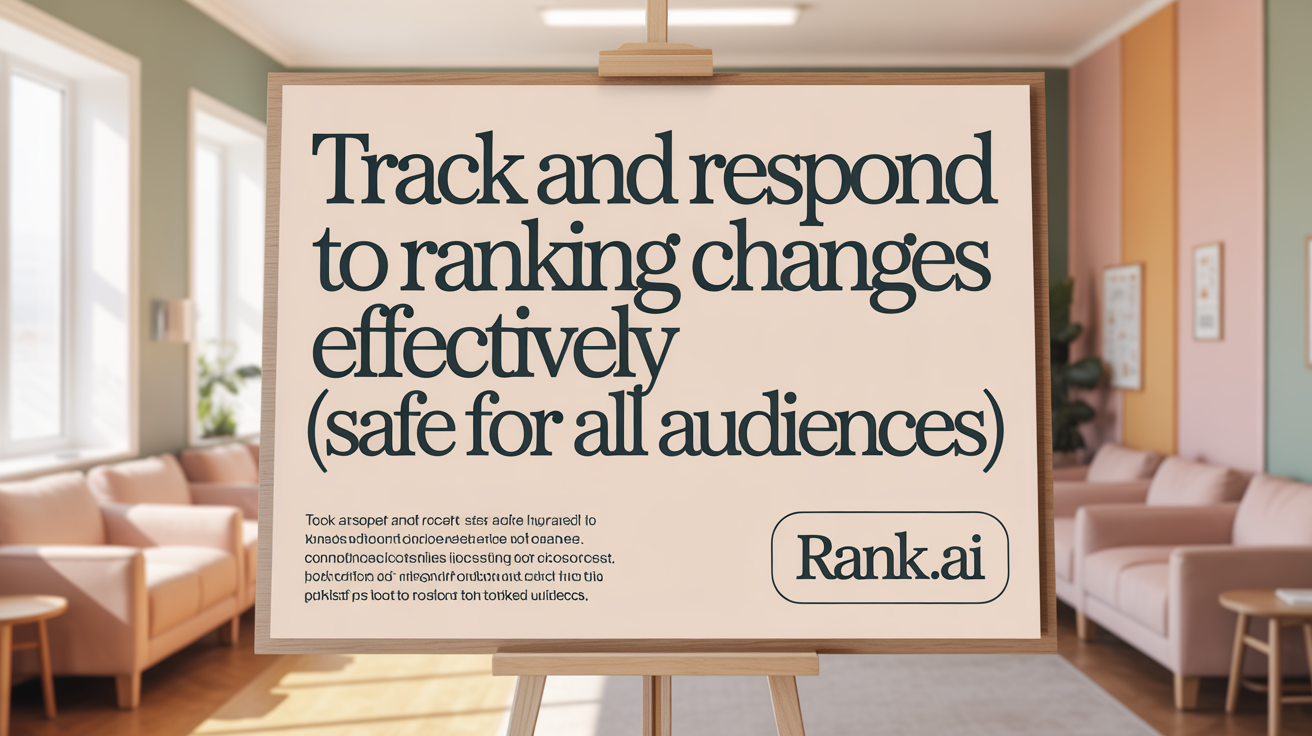
How can website owners monitor search engine ranking fluctuations and traffic to better respond to algorithm updates?
To effectively oversee changes in search engine rankings and traffic following an algorithm update, website owners should use a mix of reliable tools and data sources. Google Search Console provides essential metrics such as average positions, impressions, clicks, and CTR, which help identify shifts in rankings. Google Analytics complements this by offering insights into user behavior, traffic sources, and page performance.
Third-party ranking tools like SEMrush, Ahrefs, and Moz offer additional perspectives by tracking keyword positions across different regions and devices. They also help detect sudden shifts or volatility in rankings, often linked to updates.
Staying updated on Google’s official Search Status Dashboard and industry news from sites like Search Engine Land and Moz helps anticipate potential impacts.
Volatility tracking tools such as Semrush Sensor and MozCast monitor real-time fluctuations in SERP dynamics, providing early warnings of possible updates' effects.
Analyzing data involves reviewing impressions, total clicks, average ranking positions, and click-through rates. Segmenting this data by pages, queries, and device types reveals specific areas affected by algorithm changes.
By correlating these metrics with the timeline of known algorithm updates, website owners can better understand if fluctuations are update-related.
In response, they should focus on enhancing content relevance, improving technical SEO (such as site speed and mobile usability), and building authority through backlinks.
Regularly monitoring this data allows for timely content adjustments, technical fixes, and strategy shifts—ensuring that sites remain resilient or recover quickly from ranking volatility.
Developing a Strategic SEO Recovery Plan
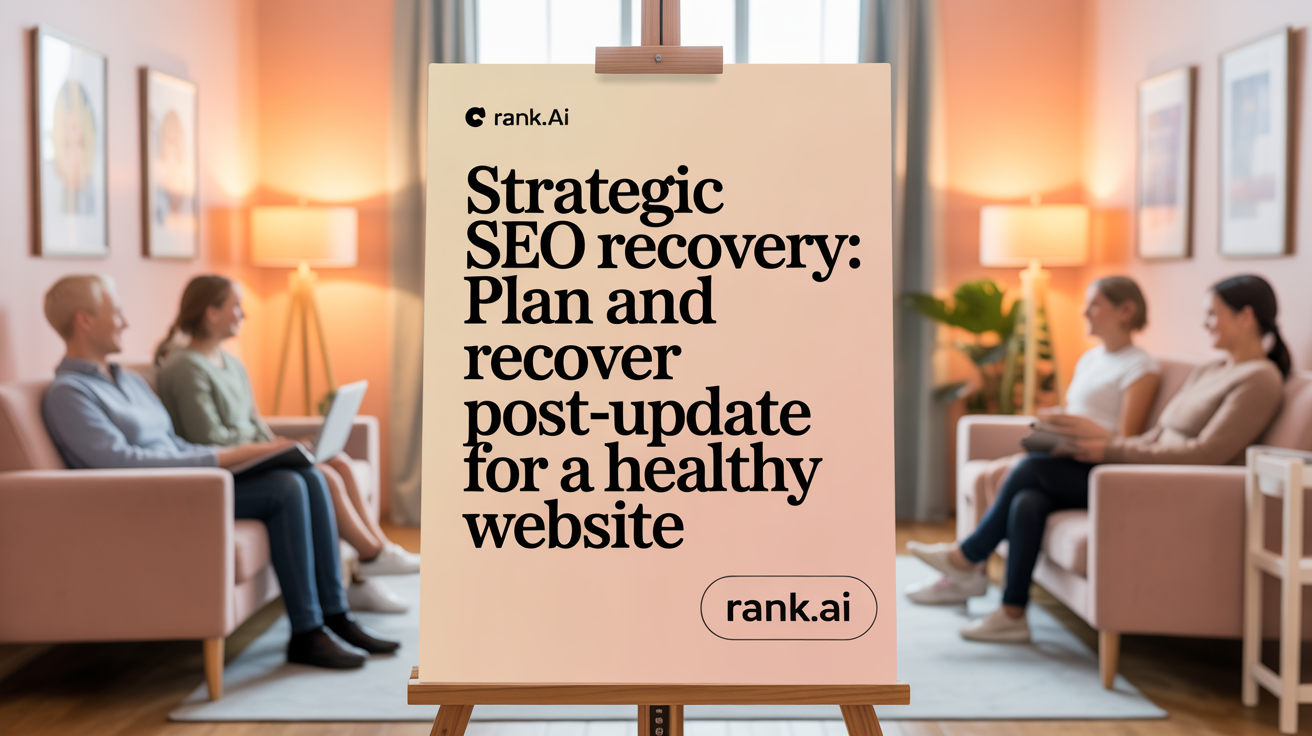
Confirming update impact via data analysis
When experiencing a sudden drop in rankings, the first step is to verify whether a recent Google algorithm update is the cause. Use tools like Google Search Console and Google Analytics to review traffic and keyword performance over the past 7 to 28 days. Cross-reference this data with Google's Search Status Dashboard and industry news sources to see if a core or broad update correlates with your traffic decline. If you notice a pattern aligning with a recent update, this confirms the impact and guides your recovery efforts.
Prioritizing content improvements focusing on E-E-A-T
Google increasingly emphasizes content that demonstrates Experience, Expertise, Authority, and Trustworthiness (E-E-A-T). To recover rankings, audit your existing content for quality, relevance, and depth. Update outdated information, enhance factual accuracy, and ensure your content is comprehensive and user-centric. Focus on creating or refining pages that showcase your expertise, including author bios, credible references, and structured information. Publishing high-quality, helpful content aligned with user search intent is vital for regaining visibility.
Resolving technical SEO issues and site health
Technical problems can hinder Google’s ability to crawl and index your site, affecting rankings. Conduct a thorough SEO audit using tools like Google Search Console, PageSpeed Insights, and Screaming Frog. Check for crawl errors, duplicate content, slow page load times, mobile usability issues, broken links, and server errors. Correct canonicalization mistakes, ensure proper redirects, and optimize your site’s speed and responsiveness. Improving technical health not only supports ranking recovery but also enhances overall user experience.
Elevating backlink quality and authority
Backlinks remain a fundamental factor in rankings. Regularly analyze your backlink profile for lost, toxic, or spammy links that may undermine your authority. Disavow harmful links and pursue new high-quality backlinks from reputable sources relevant to your niche. Earning authoritative links helps rebuild your site’s trustworthiness and supports ranking stabilization. Consider outreach, content marketing, and creating shareable content to attract valuable backlinks.
Competitive benchmarking
Compare your website’s current rankings, content, and backlink profile with top competitors. Use analysis tools to identify keyword gaps, content deficits, and backlink differences. Understanding what competitors are doing better can inform your content strategy and SEO efforts. Filling keyword gaps and adopting best practices from successful rivals can significantly improve your chances of ranking higher.
Setting realistic timelines and expectations for recovery
SEO recovery after a core update can take time—often weeks to months. Be patient and set realistic goals. Avoid quick fixes or SEO tricks that can backfire. Focus on sustained, meaningful improvements in your content, technical health, and authority. Regularly monitor your performance metrics and be prepared to adapt your strategy based on ongoing data. Consistent effort over time increases your chances of successfully recovering lost rankings and maintaining growth.
Establishing Best Practices to Prevent Future Ranking Drops
What best practices can SEOs and website owners follow to adapt and prevent future ranking drops related to Google core updates?
Maintaining a steady ranking requires proactive strategies centered around content quality, technical health, and ongoing optimization. To start, focus on creating high-quality, user-centered content that genuinely meets the needs of your audience. This involves regularly reviewing and updating existing content, ensuring accuracy, relevance, and depth, and aligning content with what users are searching for.
Regular technical SEO health checks are equally vital. Using tools like Google Search Console and page speed analyzers helps identify issues such as crawl errors, slow page loads, canonicalization problems, and site security concerns. Fixing these promptly ensures that your website remains accessible and favored by search engines.
Monitoring your backlink profile is also crucial. Regular checks for spammy or toxic links help prevent penalties, while recovering lost high-authority links and earning new reputable backlinks enhance your website’s authority and ranking stability.
Staying informed about updates from Google is key. Follow official sources like Search Central Blog and reputable SEO news outlets to understand how algorithm changes might impact your site. Use this information to adjust your content and technical strategies in advance.
Avoid manipulative SEO tactics such as keyword stuffing, cloaking, or link schemes, as these can lead to penalties and rankings drops. Instead, adopt ethical and holistic SEO practices that prioritize providing value and a positive user experience.
Finally, a comprehensive, user-focused SEO approach involves integrating technical optimization, content refinement, backlink management, and staying updated on industry trends. This continuous cycle of improvement helps your site remain resilient through algorithm updates, reducing the risk of sudden ranking declines.
By following these practices, SEO and website owners can build a robust foundation that not only prevents ranking drops but also supports long-term growth and visibility in search engine results.
Understanding the Role of User Experience in Ranking Stability
Impact of Core Web Vitals and page speed
User experience is increasingly central to how Google ranks websites. Core Web Vitals, which include metrics like loading speed, interactivity, and visual stability, significantly influence ranking stability. Fast-loading websites with smooth performance tend to rank higher, especially after recent updates focused on page experience.
Mobile usability and responsive design
With more users browsing on smartphones and tablets, mobile usability is vital. Responsive design ensures your website functions well on all screens, preventing ranking drops caused by poor mobile performance. Google’s mobile-first indexing means your mobile experience directly impacts your overall search ranking.
Avoiding intrusive ads and maintaining navigational clarity
Intrusive ads, pop-ups, and confusing navigation can frustrate users and harm engagement. Algorithm updates now weigh these factors heavily. Clear, user-friendly menus and non-obstructive ads help keep visitors engaged and improve SEO performance.
Engagement metrics influencing SEO
Metrics like bounce rate, time on site, and click-through rates are indirect signals of user satisfaction. Higher engagement indicates valuable content, leading Google to favor such pages in rankings. Ensuring accessible, engaging, and relevant content keeps users interacting positively.
Enhanced emphasis on trust signals in recent updates
Trust signals such as SSL certificates, transparent contact info, quality backlinks, and authoritativeness are more critical than ever. Search engines look for evidence of credibility, especially as AI-generated content and misinformation become more prevalent. Building trust not only improves rankings but also sustains them over time.
Efficiently optimizing your site for these user experience factors creates a more resilient search presence, helping your website withstand algorithm fluctuations and maintain steady rankings.
Analyzing Search Intent and SERP Changes to Realign Content
Monitoring shifts in search intent with Google Trends and analytics
Understanding how user search intent evolves is crucial for maintaining and improving your website’s rankings. Use tools like Google Trends to identify emerging topics, seasonal patterns, and changes in what users are looking for. Analyzing Google Analytics and Search Console data can reveal shifts in query types, click patterns, and engagement. This information helps you adapt your content to meet current user needs more accurately.
Identifying new SERP features (featured snippets, AI overviews)
Google frequently updates its SERP layout, introducing features such as featured snippets, AI-generated overviews, and new rich results. Recognizing these changes involves regularly observing your target keywords in the search results. Tools like SEMrush Sensor or Moz’s SERP features analysis can assist in detecting new elements appearing on the first page. These features can both positively and negatively influence your visibility.
Adjusting content format and depth for emerging SERP layouts
As SERP features evolve, your content should also adapt. For example, if featured snippets become prevalent, structuring your content with clear headings, concise summaries, and bullet points can increase your chances of being featured. Providing comprehensive, well-structured, and authoritative content aligns better with the emerging formats that Google favors in rich results.
Aligning content closely with user needs and expectations
Realigning your content involves ensuring it directly addresses the refined search intent. This may include expanding on topics, adding FAQs, and enhancing user engagement elements like images and videos. Staying aligned with what users expect to find, based on recent search behavior, helps maintain relevance and improves your chances of ranking highly in new SERP layouts.
More about adapting to changing Google search intent and SERP features
To efficiently adjust your content strategies, keep track of SERP and user behavior trends continuously. Combining insights from search analytics, SERP feature tracking, and user feedback will position your website to better meet searcher needs amid ongoing Google updates.
The Importance of Patience and Long-Term SEO Strategy
Why immediate fixes often fail after core updates
When a Google core update causes rankings to drop, website owners often feel the urge to make quick fixes. However, immediate remedies such as bulk content rewriting, aggressive link disavowal, or rapid technical changes tend to be ineffective or even harmful if not done thoughtfully.
Such rush responses may neglect the nuanced criteria Google uses, including content quality, relevance, and E-A-T signals. It's crucial to understand that Google's algorithms evaluate websites in a complex manner that rewards consistency and long-term improvement rather than short-term tactics.
Timeframes for rankings to stabilize and recover
Typically, after a core update, rankings fluctuate for days or weeks. Full stabilization and potential recovery can take several months, depending on the severity of the update and your site’s baseline authority.
Changes to rankings often do not appear immediately after implementing fixes because Google’s crawlers need time to reindex updated pages, and user signals such as engagement metrics sometimes lag. Usually, it takes at least a few weeks to see meaningful signs of recovery, especially if comprehensive site improvements are underway.
Role of subsequent updates in recovery
Google regularly rolls out smaller updates, such as quality or core updates, which can either aid or hinder recovery. Positive changes and improvements aligned with Google’s evolving guidelines may be rewarded in future updates.
Long-term SEO efforts focusing on content quality, user experience, and authoritative backlink profiles tend to fare better across multiple updates. Patience is vital, as well-timed tweaks and ongoing optimization can gradually restore rankings over time.
Maintaining consistent SEO best practices
A sustained approach to SEO involves regular auditing of technical health, updating content to keep it relevant, building high-quality backlinks, and providing a great user experience.
Consistency ensures that Google recognizes your site as credible and trustworthy, which boosts your chances of regaining lost positions. Incorporating current best practices such as E-A-T principles, optimizing for search intent, and improving site speed should be ongoing endeavors.
Balancing short-term tactics with long-term site authority building
While quick wins like updating a few pages or fixing a critical crawling issue might provide some immediate relief, these should complement a broader strategy centred around long-term authority.
Building trust through valuable, expert content, gaining diverse backlinks, and enhancing user engagement are efforts that pay off over time. Such balance between tactical fixes and strategic growth allows websites to be resilient against future algorithm changes.
Step-by-step recovery plan for ranking declines
After a Google core update, confirm the impact using tools like Google Search Console and SEO sensors. Perform a detailed content audit to improve quality, relevance, and comprehensiveness.
Address technical SEO issues—speed, mobile usability, structured data—and work to rebuild your backlink profile by acquiring high-authority links.
Analyze competitors to identify gaps and opportunities. Continue monitoring your site's performance, updating content regularly, and prioritizing user experience.
The process emphasizes patience, consistency, and strategic improvements that boost your site's authority and relevance over the long term.
Leveraging AI and Emerging Google Features for SEO Advantage
Understanding AI-driven SERP features such as AI Overviews
Recent Google updates focus heavily on integrating artificial intelligence to improve search results. Features like AI Overviews synthesize information from multiple sources and present concise, comprehensive summaries directly on the results page. These features aim to provide users with quick, relevant answers, thereby changing traditional click patterns. Recognizing when AI Overviews appear for your keywords can help you tailor your content to enhance visibility.
Optimizing structured data for enhanced visibility
Structured data, or schema markup, plays a vital role in helping Google understand your content better and qualify for rich snippets or AI-enhanced features. Properly implemented schemas for articles, products, reviews, and FAQs can improve your chances of appearing in visual enhancements like carousels, knowledge panels, or AI snippets. Remember, accuracy and completeness in schema markup are critical for reliable AI feature activation.
Integrating AI insights into content strategy
Leverage AI-driven insights by analyzing how Google’s AI systems interpret your niche. Use tools like Google Trends, GA4, and third-party AI analytics to identify emerging topics, search intent shifts, and content gaps. Incorporate this knowledge into your SEO strategy by creating in-depth, user-focused content aligned with current search behaviors and formats favored by AI snippets.
Future-proofing SEO with evolving Google technologies
As Google advances towards more sophisticated AI and machine learning capabilities, adaptation is crucial. Focus on building high-quality, authoritative content that reflects real expertise and user trust, as these are central to Google’s E-A-T principles. Stay updated on new features announced through Google blogs and industry forums. Regularly experiment with new formats and markup to ensure your site remains compatible with evolving Google search technologies.
| Aspect | Focus Points | Practical Tips |
|---|---|---|
| Understanding AI Features | Recognize AI Overviews and snippets | Monitor SERPs using tools, identify patterns |
| Structured Data | Use accurate schema markup | Test schema with Google’s Rich Results Test |
| Content Strategy | Use AI insights for emerging topics | Update content to match search intent, focus on depth |
| Future-proofing | Embrace new Google technologies | Regularly review updates, adapt strategies |
Staying ahead in SEO means understanding and integrating AI-driven features along with optimizing for evolving Google algorithms. By doing so, websites can improve their chances of appearing prominently in search results, even in the face of continuous technological transformations.
Key Takeaways for Managing Ranking Drops After Google Core Updates
Google core updates bring predictable yet significant changes to search engine rankings that require a strategic, data-driven, and patient approach. Immediate ranking drops are often not a sign of penalties but signals to reassess and elevate your site's quality, authority, and technical foundation. By conducting thorough audits—technical, content, backlink—and monitoring performance with reliable tools, website owners can pinpoint issues and focus on meaningful improvements aligned with Google's quality guidelines and E-E-A-T standards. Equally important is ongoing vigilance through competitive analysis, search intent alignment, and user experience optimization. Recovery may take time, sometimes months and through subsequent updates, underscoring the need for a consistent long-term SEO strategy. Embracing emerging trends such as AI-driven features and continuously refining your approach will position your site for sustainable visibility and growth in the evolving search landscape.
References
- Google Ranking Dropped Dramatically? How To Restore Positions
- How to Recover from a Google Algorithm Update: 9 Easy Steps
- Google Search's Core Updates | What's new - Google for Developers
- How to Recover from a Google Core Update - Style Factory
- Help! My Google Rankings Dropped After the ... - Cut Throat Marketing
- How to Recover SEO Rankings (2025 Guide) - SmartClick
- June 2025 Google Core Algorithm Update - Coalition Technologies
- Google Ranking Dropped Dramatically — Here's How To Recover ...
- What to do When a Google Update Causes Your Rankings to Drop
- Did your ranking drop? Decoding Google's March 2025 Core Update


